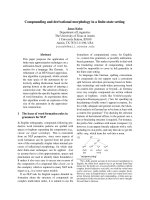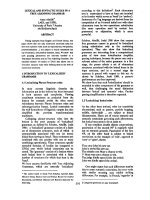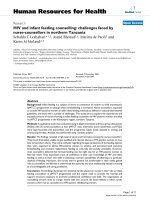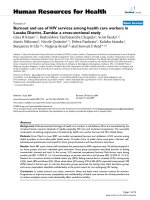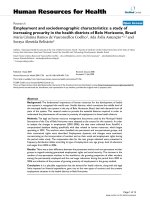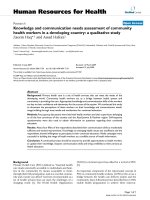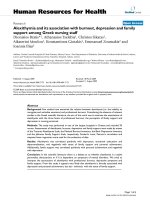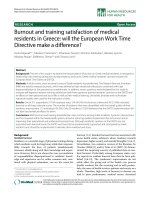báo cáo sinh học:" Motivation and job satisfaction among medical and nursing staff in a Cyprus public general hospital" pdf
Bạn đang xem bản rút gọn của tài liệu. Xem và tải ngay bản đầy đủ của tài liệu tại đây (284.25 KB, 9 trang )
RESEARC H Open Access
Motivation and job satisfaction among medical
and nursing staff in a Cyprus public general
hospital
Persefoni Lambrou
1,2
, Nick Kontodimopoulos
1*
, Dimitris Niakas
1
Abstract
Background: The objective of this study was to investigate how medical and nursing staff of the Nicosia General
Hospital is affected by specific motivation factors, and the association between job satisfaction and motivation.
Furthermore, to determine the motivational drive of socio-demographic and job related factors in terms of
improving work performance.
Methods: A previously developed and validated instrument addressing four work-related motivators (job attributes,
remuneration, co-workers and achievements) was used. Two categories of health care professionals, medical doctors
and dentists (N = 67) and nurses (N = 219) participated and motivation and job satisfaction was compared across
socio-demographic and occupational variables.
Results: The survey revealed that achievements was ranked first among the four main motivators, followed by
remuneration, co-workers and job attributes. The factor remuneration revealed statistically significant differences
according to gender, and hospital sector, with female doctors and nurses and accident and emergency (A+E)
outpatient doctors reporting greater mean scores (p < 0.005). The medical staff showed statistically significantly
lower job satisfaction compared to the nursing staff. Surgical sector nurses and those >55 years of age reported
higher job satisfaction when compared to the other groups.
Conclusions: The results are in agreement with the literature which focuses attention to management approaches
employing both monetary and non-monetary incentives to motivate health care professionals. Health care
professionals tend to be motivated more by intrinsic factors, implying that this should be a target for effective
employee motivation. Strategies based on the survey’s results to enhance employee motivation are suggested.
Background
Motivation can be defined as the processes that account
for an individual’s intensity, direction and persistence of
effort toward attaining a goal [1]. In most cases motiva-
tion stems from a need which must be fulfilled, and this
in turn leads to a specific behavior. Fulfillment of needs
results in some type of reward, which can be either
intrinsic or extrinsic. The former are derived from
within the individual, e.g. taking pride and feeling good
about a job well-done, whereas the latter pertain to
rewards given by another person [2]. Job satisfaction, on
the other hand, is defined as a pleasurable or positive
emotional state, resulting from the appraisal of one’s job
or job experiences.
Psychologists have studied human motivation exte n-
sively and have formulated a variety of theories about
what motivates people. Needs-based theories include
Maslow’ s hierarchy of need, Aldersfer’stheory,Herz-
berg’ s two factor theory and McClelland’ sacquired
needs theory. Another approach focuses on external fac-
tors and their role in understanding employee motiva-
tion (e.g. Skinner’ s reinforcement theory). Theories
based on intrinsic factors focus on internal thought pro-
cesses and perceptions about motivation (e.g. Adam’s
equity theory, Vroom’s expectancy theory, L ocke’ sgoal
setting theory) [2].
In the health care field, attaining health objectives in a
population depends to a large extent on the provision of
* Correspondence:
1
Faculty of Social Sciences, Hellenic Open University, Bouboulinas 57, 26222,
Patras, Greece
Full list of author information is available at the end of the article
Lambrou et al. Human Resources for Health 2010, 8:26
/>© 2010 Lambrou et al; licensee BioM ed Central Ltd. This is an Open Access article distributed under the terms of the Creative
Commons Attribution License ( icenses/by/2.0), which permits unrestricted use, distribution, and
reproduction in any medium, provided the original work is properly cited.
effective, efficient, accessible, viable and high-quality
services. The health workforce, prese nt in sufficient
numbers and appropriately allocated across different
occupations and geographical regions is arguably the
most important input in a unique production process
and has a strong impact on overall health system perfor-
mance [3]. The lack of explicit policies for human
resource management has produced, in most countries,
imbala nces that threaten the capacity of health care sys-
tems to attain their objectives [4].
The workforce in the health sector has specific features
that cannot be ignored and motivation can play an integral
role in many of the compelling challenges facing health-
care today [5]. In this area, the task of motivation is exa-
cerbated by i) the nature of the economic relationship
between those using the system and the system itself (phy-
sicians, patients and hospitals) and ii) the heterogeneity of
the workforce to be managed [6]. Health organizations are
faced with external pressures that cannot be effectively
met without appropriate adjustments to the workforce
and the development of the workforce thus appears to be
a crucial part of the health policy development process [7].
Cyprus has been a member of EU since 2004. The
health system is a typical South Mediterranean system,
with provision of health care services from both the pri-
vate and public sectors. Cyprus has the second lowest
share of public expenditure to total health expenditure
(43.2%), with the latter approximating 6% of the GDP.
Health indicators are above the EU average, with life
expectancy at 78.8 and 82.4 years for males and females
respectively [8]. The public health sector system consists
of eight hospitals and a number of primary health care
centers around the coun try. The hospitals offer services
for primary, secondary and tertiary care. The health sys-
tem is currently undergoing major changes, and in 2011
a new General Health System is expected to be imple-
mented, which is to be based on contributions by the
employers and the employees.
Human resources management practices in the public
health sector in Cyprus are centralized. Recruitment and
selectio n is conducted by the Civil Ser vice Committ ee
(appointed by the President of the Republic every five
years). Consequently, ho spital management is practically
unable to ensure employee motivation, due to a lack of
autonomy. There is a problem of split accountability of
personnel, as do ctors and other health professionals are
accountable centrally to the Medical Services, dentists to
the Dental Services, psychiatrists to the Mental Health
Services and administrative officers to the Ministry of
Finance and other Ministries. All public sector physicians
are salaried employees of the Ministry of Health and
belong to a centralize d civil service staffing system that
allocates them to posts based on defined needs. A plan to
make hospitals autonomous is now in place in the
Ministry of Health, and it is emphasized that the develop-
ment of this autonomy will be the prerequisite of the
implementation of the new General Health System [9].
Although employee motivation is a significant element
of health systems’ performance, it is largely understudied
[10]. The purpose of this study was to investigate: i)
how medical and nursing staff of the Nicosia General
Hospital i s affected by specific motivation factors, ii) the
association between job satisfaction and motivation iii)
the motivational drive of socio-demographic and job
related factors in terms of improving performance in
this hospital. A validated instrument[11]addressing
four work-related motivators (job attributes, remunera-
tion, co-workers and achievements)wasused.Twocate-
gories of health care professionals, doctors (including
dentists) and nurses working in the hospital participated.
Job satisfaction was cross-related to these motivational
factors. The main focus was on potential differences
between the two categories of professionals.
Methods
Instrument
An instrument developed for measuring motivation
based on Maslow’sandHerzberg’stheorieswasusedin
the present study. It consists of 19 items which are
grouped under four distinct motivational factors. The
job attributes factor encompasses 7 items: authority,
goals, creativity opportun ities, clear d uties, job c ontrol,
skill exploitation and decision-making. The remune ra-
tion factor encompasses 4 items: salary, environment,
retirement/pension and absenteeism. The co-workers
factor encompasses 5 items: teamwork, job pride, appre-
ciatio n, supervisor and fairness. The ach ievements factor
encompasses 3 items: job meaningfulness, earned
respect and interpersonal relationships [11]. All items
are neutrally phrased as “ I n your case, how important
is for in creasing your wil l to perform better at work?”.
Responses are provided on a five-point unipolar adjec-
tive scale, in which 1 corresponds to “not at all”,2to“a
little bit”,3to“moderately”,4to“very” and 5 to “extre-
mely. The survey included a single question relevant to
job satisfaction which was measured on a 1-5 scale as
well. The most frequently argued advantages of single
item measures for measuring overall job satisfaction are
brevity, increased face validity, high correlation with
multi-item satisfaction measures and increased sensit iv-
ity in measuring changes in job sat isfaction [12,13].
Socio-demographic data on age, gender, education, and
work-related data such as years in service, department
and managerial position were also collected.
Sample and data collection
The present study was conducted in the Nicosia General
Hospital whic h is the largest on the island with a
Lambrou et al. Human Resources for Health 2010, 8:26
/>Page 2 of 9
capacity of 414 beds. Its operation s tarted in 2007 and
today it employs 161 doctors and 770 nurses. The ques-
tionnaire was randomly distributed to 50% of the medi-
cal doctors (including dentists) and nurses between
November and December 2008. In total 67 doctors and
219 nurses responded to the questionnaire, with an
overall response rate of 76.6%. Clinical departments
were grouped into 4 sectors: accident and emergency
(A+E) outpatients’ clinics constituted one sector, general
surgery, angiothoracic, anesthetic, dental, E.N.T., plastic
surgery, neurosurgery, orth opedic, urology and the nur-
sing personnel of the operatin g theatres constituted the
surgical sector, I.T.U., medical, cardiology, renal, oncol-
ogy, dermatology and the chest clinic constituted the
medical sector and X-ray, pathology and forensic medi-
cine constituted the laboratory sector.
Analysis
The sample was analyzed as a whole and by professional
subgroup. For each motivation factor, summated scores
were calculated on a 1-5 scale, with higher scores corre-
spondi ng to higher motivation to perform better by that
particular factor. Parametric t -test and ANOVA were
used for comparisons according to gender, education,
age and job-related variables such as years in service,
department and if the respondent appr aised subordi-
nates. Multivariate analyses, with each motivation factor
the dependent variable, and sociodemographic, work-
related and job satisfaction variables as independent pre-
dictors were conducted. Internal consistency reliability
was tested via Cronbach’ s alpha coefficient and com-
pared with the respective values observed during the
development of the instrument [11]. All analyses
were perform ed with SPSS version 15.0 (SPSS Inc., Chi-
cago IL).
Results
The sample frequency distribution, according to demo-
grap hic and work-related variables, is shown in Tab le 1.
The majority of the respondents were female (68.5%)
mostly due to the large number of female nurses, and
the mean time serving in the public health sector was
14.1 years. By subgroup, doctors were predominantly
males (64.2%), whereas nurses were females (78.5%).
The age distribution was: 12.6% under 25 years old,
25.9% between 25 and 35, 22.0% between 36 and 45,
29.7% between 46 and 55 and 9.8% over 55. Regarding
hospital sector, 39.9% were from the medical sector,
31.5% from the surgical sector, 26.2% from A+E outpati-
ents sector and 2.4% were from the Lab sector. Only
23.4% of the respondents were responsible for managing
other people.
The m ean scores for each motivating factor are
shown in Table 2. The highest ranked motivator was
achievements, which was significantly higher than all the
others both for the overall sample, and by professional
subgroup. The second highest ranked motivator overall
was remuneration, however doctors ranked co-workers
as the second strongest motivating factor. The scores
for remuneration were statistically significantly diffe rent
overall and by subgroup. The lowest ranked motivator
by both groups was job attributes. The four scales
showed high internal consistency reliability and Cron-
bach’s alpha coefficient was found t o be in accordance
with the respective developmental values [11]. Specifi-
cally, alpha was 0.838 (compared to 0.822 reported in
Table 1 Overall and sub-sample frequency distribution by
demographic and job-related variables
Demographic variables Overall
(N = 286)
Doctors/
Dentists (N = 67)
Nurses
(N = 219)
Gender
Male 90 (31.5%) 43 (64.2%) 47 (21.5%)
Female 196 (68.5%) 24 (35.8%) 172 (78.5%)
Sector
Medical 114 (39.9%) 19 (28.4%) 95 (43.4%)
Surgical 90 (31.5%) 20 (29.8%) 70 (31.9%)
A+E/Outpatients 75 (26.2%) 21 (31.4%) 54 (24.7%)
Laboratory 7 (2.4%) 7 (10.4%) -
Age group
<25 36 (12.6%) - 36 (16.4%)
25-35 74 (25.9%) 4 (5.9%) 70 (31.9%)
36-45 63 (22.0%) 21 (31.4%) 42 (19.3%)
46-55 85 (29.7%) 25 (37.3%) 60 (27.4%)
>55 28 (9.8%) 17 (25.4%) 11 (5.0%)
Years in public service
<5 83 (29.0%) 16 (23.9%) 67 (30.6%)
5-10 50 (17.5%) 17 (25.4%) 33 (15.1%)
11-20 70 (24.5%) 20 (29.9%) 50 (22.9%)
21-30 58 (20.3%) 13 (19.3%) 45 (20.5%)
>30 25 (8.7%) 1 (1.5%) 24 (10.9%)
Management position
Yes 67 (23.4%) 18 (26.8%) 49 (22.4%)
No 219 (76.6%) 49 (73.2%) 170 (77.6%)
Table 2 Mean scores
1
(SD) by motivating factor and job
satisfaction for the entire sample and by professional
subgroup
Overall
(N = 286)
Doctors/
Dentists (N = 67)
Nurses
(N = 219)
Remuneration 3.65 (1.02) 3.58 (1.07) 3.67 (1.01)
Job attributes 3.37 (0.98) 3.55 (1.03) 3.32 (0.96)
Coworkers 3.59 (0.99) 3.67 (1.07) 3.57 (0.96)
Achievements 4.18 (0.85) 4.26 (0.85) 4.16 (0.85)
Job satisfaction 3.21 (1.01) 3.07 (1.10) 3.25 (0.97)
1
Reported on a 1-5 scale with higher values corresponding to higher
motivation
Lambrou et al. Human Resources for Health 2010, 8:26
/>Page 3 of 9
the validation study) for remuneration, 0.744 (0.782) for
achievements, 0.847 (0.826) for co-workers and 0.897
(0.901) for attributes. On the other hand, the single-
item satisfaction scale showed a moderate correlation
with each of the motivation factors, with Pearson ’sr
ranging between 0.303-0.382 (P < 0.001).
Scores by demogr aphic and work-related variables for
the remuneration factor, which encompasses extrinsic
motivators such as salary, benefits, pension and vacation
schemes are shown in Table 3. Interestingly, the moti-
vating effect of remuneration was significantly different
by professional category, and appeared to be influenced
by gender and by sector (for docto rs). Specifically,
female doctors reported being motivated significantly (P
< 0.05) more by remune ration than their male counter-
parts. Furthermore, doctors working in the A+E
outpatients sector were motivated more by remunera-
tion (P < 0.05) than those working elsewhere.
Job attributes encompasse s intrinsic motivators such
as decision-making, creativity and skill exploitation. This
factor appears (Table 4) to motivate doctors more than
nurses and specifically the respondents in managerial
positions. Female doctors reported being more moti-
vated by this factor than their male colleagues. Those
working in the A+E outpatie nts sector, nurses >55 years
old and those working >30 years scored higher. Interest-
ingly, only one statistically significant difference was
observed in the analyses for this motivator, and specifi-
cally nurses in management positions compared to
those not having such responsibilities (P = 0.049).
The co-workers motivator (Table 5) refers to profes-
sional relation ships with supervisors and collea gues as a
Table 3 Mean scores
1
(SD) by demographic and job-
related variables for the REMUNERATION motivator
Demographic variables Overall
(N = 286)
Doctors/
Dentists (N = 67)
Nurses
(N = 219)
Gender
Male 3.36 (0.99) 3.35 (1.09) 3.36 (0.90)
Female 3.78 (1.01) 4.01 (0.90) 3.75 (1.02)
P-sig.
2
0.010 0.015 0.020
Sector
Medical 3.53 (1.15) 2.93 (1.01) 3.65 (1.14)
Surgical 3.78 (0.94) 3.76 (1.05) 3.78 (0.92)
A+E/Outpatients 3.65 (0.89) 3.92 (0.98) 3.54 (0.84)
Laboratory 3.85 (0.89) 3.85 (0.89) -
P-sig.
3
0.365 0.014 0.420
Age group
<25 3.93 (1.09) - 3.93 (1.09)
25-35 3.59 (1.01) 3.50 (1.67) 3.60 (0.97)
36-45 3.61 (0.96) 3.38 (1.11) 3.72 (0.67)
46-55 3.68 (1.02) 4.04 (0.79) 3.54 (1.07)
>55 3.41 (1.07) 3.20 (1.06) 3.72 (1.06)
P-sig.
3
0.328 0.055 0.433
Years in public service
<5 3.68 (1.11) 3.48 (1.45) 3.73 (1.05)
5-10 3.41 (1.15) 3.41 (1.15) 3.81 (0.96)
11-20 3.64 (0.83) 3.72 (0.69) 3.61 (0.88)
21-30 3.55 (1.02) 3.63 (1.09) 3.52 (1.01)
>30 3.73 (1.22) 5.00 (-) 3.67 (1.22)
P-sig.
3
0.936 0.621 0.747
Management position
Yes 3.75 (0.99) 3.52 (1.04) 3.84 (0.97)
No 3.61 (1.03) 3.61 (1.08) 3.62 (1.01)
P-sig.
2
0.333 0.777 0.178
1
Reported on a 1-5 scale with higher values corresponding to higher
motivation
2
According to t-test
3
According to ANOVA
Table 4 Mean scores
1
(SD) by demographic and job-
related variables for the JOB ATTRIBUTES motivator
Demographic variables Overall
(N = 286)
Doctors/
Dentists (N = 67)
Nurses
(N = 219)
Gender
Male 3.23 (1.02) 3.38 (1.11) 3.10 (0.92)
Female 3.44 (0.96) 3.86 (0.81) 3.38 (0.96)
P-sig.
2
0.108 0.065 0.086
Sector
Medical 3.32 (1.00) 3.29 (0.94) 3.32 (1.01)
Surgical 3.46 (0.92) 3.67 (1.13) 3.40 (0.85)
A+E/Outpatients 3.34 (1.05) 3.68 (1.15) 3.20 (0.99)
Laboratory 3.55 (0.60) 3.55 (0.60) -
P-sig.
3
0.717 0.625 0.535
Age group
<25 3.32 (0.94) - 3.32 (0.94)
25-35 3.23 (1.00) 3.10 (1.40) 3.24 (0.99)
36-45 3.39 (1.06) 3.39 (1.31) 3.39 (0.93)
46-55 3.42 (0.50) 3.88 (0.65) 3.23 (0.93)
>55 3.62 (1.01) 3.38 (0.99) 4.00 (0.95)
P-sig.
3
0.458 0.249 0.157
Years in public service
<5 3.28 (0.98) 3.30 (1.17) 3.27 (0.94)
5-10 3.43 (1.04) 3.48 (1.27) 3.40 (0.93)
11-20 3.44 (0.90) 3.80 (0.58) 3.30 (0.97)
21-30 3.33 (0.93) 3.46 (1.05) 3.30 (0.90)
>30 3.46 (1.19) 5.00 (-) 3.40 (1.17)
P-sig.
3
0.089 0.383 0.963
Management position
Yes 3.62 (0.89) 3.78 (0.99) 3.55 (0.86)
No 3.30 (0.99) 3.47 (1.05) 3.25 (0.98)
P-sig.
2
0.089 0.277 0.049
1
Reported on a 1-5 scale with higher values corresponding to higher
motivation
2
According to t-test
3
According to ANOVA
Lambrou et al. Human Resources for Health 2010, 8:26
/>Page 4 of 9
source of satisfaction and motivation. The scores for this
factor were practically identical in all groups and no sta-
tistically significant differences were observed. This
motivator was ranked second among doctors and third
among nurses. Respondents working in the surgical and
A+ E outpatient sectors reported being more motivated
by these aspects, than those working in the other sec-
tors. Well-established professional relationships moti-
vated nurses in managerial positions and those aged >55
years old.
Scores for the achievements factor, which refers to
intrinsic motivators such as pride, appreciation, respect
and social acceptance are shown in Table 6. This moti-
vator was ranked as the strongest by both doctors and
nurses. However, the do ctor and nurse subgroup
analyses did not reveal any statistically significant
differences. Regarding the scores for job satisfaction
(Table 7), the medical staff presented statistically signifi-
cant lower ratings compared to the nursing staff. The
subgroup analyses showed statistically significant differ-
ences in 4 cases. The most determining variable was
age, which was associated with higher satisfaction for
doctors in the 46-55 age group and for nurses >55 years
old (P < 0.01). More years in publi c service was reported
as a significant source of satisfaction for nurses (P = 0.01),
as was working in the surgical sector as well (P < 0.05).
In a series of multivariate analyses, each motivational
factor was regressed against socio-demographic variables
(gender, age), work related variables (years in service,
managing people) and job satisfaction, and the results
are presented in Table 8. Reporting high satisfaction
from work was positively and significantly associated
with higher scores in all motivational factors, for both
professional categories. The only motivator significantly
Table 5 Mean scores
1
(SD) by demographic and job-
related variables for the COWORKERS motivator
Demographic variables Overall
(N = 286)
Doctors/
Dentists (N = 67)
Nurses
(N = 219)
Gender
Male 3.52 (1.02) 3.65 (1.12) 3.40 (0.93)
Female 3.62 (0.97) 3.70 (1.00) 3.61 (0.97)
P-sig.
2
0.401 0.836 0.181
Sector
Medical 3.55 (1.00) 3.47 (0.95) 3.56 (1.02)
Surgical 3.63 (0.89) 3.78 (1.20) 3.59 (0.79)
A+E/Outpatients 3.61 (1.08) 3.78 (1.08) 3.54 (1.08)
Laboratory 3.57 (1.09) 3.57 (1.09) -
P-sig.
3
0.943 0.779 0.965
Age group
<25 3.56 (0.85) - 3.56 (0.85)
25-35 3.59 (0.93) 3.55 (1.32) 3.59 (0.92)
36-45 3.54 (1.06) 3.42 (1.21) 3.60 (0.99)
46-55 3.55 (1.03) 3.92 (0.95) 3.40 (1.03)
>55 3.87 (1.02) 3.63 (1.02) 4.23 (0.94)
P-sig.
3
0.649 0.488 0.125
Years in public service
<5 3.54 (0.92) 3.60 (1.23) 3.53 (0.84)
5-10 3.77 (0.98) 3.65 (1.22) 3.83 (0.85)
11-20 3.55 (1.03) 3.65 (0.99) 3.51 (1.08)
21-30 3.48 (0.92) 3.70 (1.01) 3.41 (0.90)
>30 3.77 (1.24) 5.00 (-) 3.72 (1.24)
P-sig.
3
0.469 0.814 0.344
Management position
Yes 3.66 (1.05) 3.62 (1.14) 3.68 (1.03)
No 3.57 (0.97) 3.68 (1.06) 3.54 (0.94)
P-sig.
2
0.507 0.822 0.367
1
Reported on a 1-5 scale with higher values corresponding to higher
motivation
2
According to t-test
3
According to ANOVA
Table 6 Mean scores
1
(SD) by demographic and job-
related variables for the ACHIEVEMENTS motivator
Demographic variables Overall
(N = 286)
Doctors/
Dentists (N = 67)
Nurses
(N = 219)
Gender
Male 4.13 (0.83) 4.19 (0.94) 4.08 (0.73)
Female 4.20 (0.85) 4.38 (0.67) 4.18 (0.87)
P-sig.
2
0.517 0.376 0.489
Sector
Medical 4.84 (0.81) 4.26 (0.52) 4.11 (0.85)
Surgical 4.32 (0.85) 4.38 (1.03) 4.30 (0.80)
A+E/Outpatients 4.08 (0.90) 4.15 (0.95) 4.04 (0.88)
Laboratory 4.23 (0.87) 4.23 (0.87) -
P-sig.
3
0.288 0.876 0.207
Age group
<25 4.31 (0.85) - 4.31 (0.85)
25-35 4.13 (0.86) 4.00 (0.98) 4.14 (0.96)
36-45 4.15 (0.81) 4.26 (0.87) 4.09 (0.79)
46-55 4.11 (0.87) 4.29 (0.80) 4.04 (0.90)
>55 4.42 (0.79) 4.27 (0.95) 4.66 (0.33)
P-sig.
3
0.408 0.941 0.166
Years in public service
<5 4.22 (0.81) 4.16 (0.76) 4.23 (0.83)
5-10 4.37 (0.75) 4.43 (0.88) 4.34 (0.68)
11-20 4.02 (0.89) 4.20 (0.81) 3.96 (0.92)
21-30 4.08 (0.86) 4.20 (1.05) 4.05 (0.81)
>30 4.36 (0.96) 5.00 (-) 4.33 (0.97)
P-sig.
3
0.147 0.790 0.162
Management position
Yes 4.24 (0.90) 4.12 (1.10) 4.29 (0.83)
No 4.16 (0.83) 4.31 (0.75) 4.12 (0.85)
P-sig.
2
0.487 0.442 0.221
1
Reported on a 1-5 scale with higher values corresponding to higher
motivation
2
According to t-test
3
According to ANOVA
Lambrou et al. Human Resources for Health 2010, 8:26
/>Page 5 of 9
affected by variables other than satisfaction was
remuneration. Specifically in the nurses group, stronger
motivation by remuneration aspects was associated with
female gender, fewer ye ars in service and occupying a
managerial position, whereas in the doctors subgroup
with female gender. This variable (i.e. gender) was also a
significant predictor for motivation by job attributes for
doctors.
Discussion
Cyprus’s health system faces challenges such as acces-
sion into the E.U., introduction of a new general health
insurance system and the introduction of advanced
medical technology. Changes in health care are continu-
ous and at an accelerated pace; with these changes the
need for more inspiring employees is emerging. How
does one m otivate employees in the face of increased
demands, particularly when they are being asked to
meet these demands with fewer resources? Motivation
plays an inte gral role in many of t he compelling chal-
lenges facing the health workforce today. Motivation
theories classify sources of motivation into those intrin-
sic and those extrinsic to work. Thus, exploration of the
motivating factors for today’ shealthworkforcemay
yiel d valuable insight into many of the challenges facing
modern hospitals. Meeting the needs and achieving the
goals of both the employee and the organization is the
cornerstone of job satisfaction and this is of crucial
importance for management, as it is correlated with the
upgrading of the quality of the services provided [14].
One objective of this study was to investigate how
medical and nursing staff of the largest public hospital
in Cyprus, namely the Nicosia General Hospital, was
affected by four specific motivation factors. A validated
questionnaire based on Maslow’ s needs theory and
Herzberg’s two factor theory was used. The motivational
Table 7 Mean scores
1
(SD) by demographic and job-
related variables for JOB SATISFACTION
Demographic variables Overall
(N = 286)
Doctors/
Dentists (N = 67)
Nurses
(N = 219)
Gender
Male 3.18 (1.07) 3.14 (1.12) 3.23 (1.05)
Female 3.21 (0.98) 2.96 (1.08) 3.26 (0.97)
P-sig.
2
0.813 0.524 0.893
Sector
Medical 3.14 (1.02) 3.26 (1.14) 3.11 (1.00)
Surgical 3.34 (0.98) 2.70 (1.08) 3.52 (0.88)
A+E/Outpatients 3.12 (1.02) 3.09 (1.13) 3.12 (0.99)
Laboratory 3.57 (0.78) 3.57 (0.78) -
P-sig.
3
0.307 0.236 0.015
Age group
<25 3.19 (0.95) - 3.19 (0.95)
25-35 2.91 (1.04) 2.25 (0.95) 2.95 (1.04)
36-45 3.03 (0.96) 2.66 (1.11) 3.21 (0.84)
46-55 3.52 (0.95) 3.52 (1.04) 3.53 (0.92
>55 3.42 (0.99) 3.11 (0.99) 3.90 (0.83)
P-sig.
3
0.001 0.023 0.002
Years in public service
<5 3.06 (1.06) 3.12 (1.20) 3.04 (1.03)
5-10 2.96 (1.00) 2.88 (1.16) 3.00 (0.93)
11-20 3.24 (0.95) 3.35 (0.98) 3.20 (0.94)
21-30 3.31 (0.90) 2.84 (1.14) 3.44 (0.78)
>30 3.88 (0.97) 3.00 (-) 3.91 (0.97)
P-sig.
3
0.002 0.684 0.010
Management position
Yes 3.40 (1.02) 3.16 (1.09) 3.48 (0.86)
No 3.15 (1.02) 3.04 (1.11) 3.18 (1.00)
P-sig.
2
0.074 0.683 0.053
1
Reported on a 1-5 scale with higher values corresponding to higher
motivation
2
According to t-test
3
According to ANOVA
Table 8 Multivariate analyses for motivation factors by professional category
B Coefficient (p value)
JOB ATTRIBUTES REMUNERATION CO-WORKERS ACHIEVEMENTS
Model Doctors/Dentists Nurses Doctors/Dentists Nurses Doctors/Dentists Nurses Doctors/Dentists Nurses
Constant 1.782
(0.001)
2.180
(<0.001)
1.699
(0.002)
1.676
(<0.001)
2.732
(<0.001)
2.242
(<0.001)
3.589
(<0.001)
3.128
(<0.001)
Female 0.548
(0.028)
0.710
(0.006)
0.369
(0.018)
Age
(10-year groups)
Years in service -0.022
(0.001)
Management position 0.389
(0.030)
Job satisfaction 0.335
(0.003)
0.351
(<0.001)
0.301
(0.008)
0.364
(<0.001)
0.306
(0.010)
0.409
(<0.001)
0.219
(0.021)
0.318
(<0.001)
R
2
= 0.152 0.124 0.158 0.146 0.058 0.168 0.066 0.130
Lambrou et al. Human Resources for Health 2010, 8:26
/>Page 6 of 9
factors investigated were job attributes, remuneration,
co-workers and achievements.Intotal,286employees
responded to the questionnaire, 67 medical doctors
(including 8 dentists) and 219 nurses. The survey
revealed that achievements were ranked as first among
the four main motivators, followed by remunera tion, co-
workers and job attributes. Achievements,whichisan
intrinsic factor, was the main motivator in both the doc-
tor and nurse subgroups. Thus, delegation of authority,
recognition of personnel efforts, opportunit ies for pro-
motion and the job enrichment must be a part of the
hospital human resource strategy [15-17]. Aspects
encompassed in remuneration also appeared to be very
important to the respondents. Nevertheless, due t o the
strict legal remuneration framework in the public ser-
vice, any deviations regarding this issue are limited.
A recent Greek study having used the same instru-
ment resulted in similar findings [18], i.e. achievements
once again was the most profound motivator in the
three professional subgroups investigated (doctors,
nurses and office workers) and in t he overal l sample (N
= 1353). Agreement was also observed in that remu-
neration and co-workers followed closely, and job attri-
butes again had the least influence on motivation. It is
worth mentioning however that the Greek study was
focused on comparing motivation in the public and pri-
vate health care secto rs, implying that its results may
not be directly comparable to the present study.
Our results are in line with findings from similar stu-
dies in which different data collection methods were
employed. One study conducted in two very different
cultural and socio-economic environments (Jordan and
Georgia) reported self-efficacy, pride and values as
important motivational parameters [19], i.e. constructs
which fall under our achievements factor. Another study
conducted in two African countries, namely Benin and
Kenya, which used qualitative interviews also demon-
strated the importance of non-financial incentives in
increasing the m otivation of health professionals [20].
Qualitative studies from Vietnam [21] and Tanzania
[22] showed mot ivation to be influenced by both finan-
cial and non-financial incentives and motivating factors
were appreciation by managers, colleagues and the com-
munity, a stable job and income and training. A study
from Mali based on a mixed-methods approach showed
the importance of adapting or improving upon perfor-
mance management strategies to influence staff motiva-
tion [23]. Finally, a German study addressing satisfaction
among physicians clearly showed that work and profes-
sion related variables were more important than finan-
cial situation [24].
Several interesting points worth mentioning arose
from this study. For example, female doctors and nurses
reported being more motivated by remuneration
compared to their male counterparts. This same factor
was also significant for accident/emergency outpatient
doctors, but not nurses. A possible explanation may be
that this is the only category of doctors working under a
rotational shift system (compared to all of t he nurses),
and that extra wages may be a way of overcoming their
potential dissatisfaction. Another interesting observation
was that job satisfaction was higher, (implying higher
motivation as well) in nurses in managerial positions
and those aged >55 years. Nurses overall showed higher
satisfaction from their work compared to doctors, a
finding which is interesting yet contradictory to results
from a recent Greek study reporting tha t nurses were
less satisfied than other health care professionals [25],
which may be explained by the fact the latter study was
conducted in a mental health setting.
The results from thi s study could be potentially
important in terms of human resource management
policies to be applied in this particular setting. As pre-
viously mentioned, intrinsic motivators (e.g. work mean-
ingfulness, strong interpersonal relationships, respect
etc.) have been shown to have a positive effect on ser-
vice quality, implying that the hospital’s administration
could start its effort to motivate doctors a nd nurses.
Frequent goal-setting meetings with their representatives
might be a start, i.e. a type of quality circle to mutually
identify, analyze and solve work-related problems in
order to improve the performance of the hospital, and
motivate and enrich the work of employees. In this line
of discussion, the Ministry of health’s plan to make hos-
pitals autonomous could be supported by a manage-
ment-by-objectives strategy, aiming first and foremost to
exploit the existing workforce by attempting t o satisfy
and motivate it.
In an attempt to cross-relate motivation with job satis-
faction, the latter was assessed via a single question with
a five-point response scale. The medical staff presented
statistically significant lower ratings in job satisfaction
compared to the nursing staff, a f inding not in accor-
dance with findings from another recent study in Greece
conducted in the mental health care sector [25]. Our
findings require further exploration, perhaps via a larger
sample o f health care professionals. Job satisfaction was
statistically significantly higher for surgical sector nurses
and those in the >55 age group. Similar results have
been observed in recent job satisfaction studies [26-28].
The satisfaction scale showed a moderat e correlation
with all motivational factors, with Pearson’ srranging
between 0.303-0.382. Although the association was sig-
nificant (P < 0.001), these correlations mean that job
satisfaction accounts for only 8.9%-14.3% of the variance
in the motivation factors. The terms job satisfaction and
motivation are often -but wrongly- used interchangeably
in verbal (and often in written) communication; however
Lambrou et al. Human Resources for Health 2010, 8:26
/>Page 7 of 9
there is a clear distinction between them. Job satisfaction
is a person’s emotional response to his or her job condi-
tion, whereas moti vatio n isthedrivingforcetopursue
and satisfy needs. However, job satisfaction and motiva-
tion work together to increase job performance and
healthcare organizations can do many things to increase
job satisfaction, primarily by focusing on the motivating
interests of existing and future staff [29].
To further interpret the motivational factors addressed
in the present study, we attempt to link them to time-
less motivational theories. Specifically, remuneration can
be linked to the lower level of Maslow’s needs pyramid
(physiological and safety). The co-workers factor is
equivalent to the third level of the pyramid described as
social needs. The establishment of respect, trust and
communication between co-workers is very important
among these professional groups [30]. Job attributes has
an apparent assoc iation with the fourth level (esteem)
and the intrinsic factor achievements is linked to the
highest level, self-actu alizatio n. According to Herzberg ’ s
two-factor theory, remuneration and co-workers are
hygiene factors. While these do not motivate, they can
satisfy if handled properly. O n the other hand, factors
job attributes and achi evement are motivation factors
because they create satisfaction by fulfilling an indivi-
dual’s higher needs. Once hygiene factors are met, the
mot ivation factors will, according to Herz berg, promote
job satisfaction and encourage better performance. How-
ever the link between the motivational factors and the
above-mentioned theories presented in this paper is
purely tentative and requires further substantiation in
future studies.
The formulation of a structured personnel manage-
ment strategy could have a positive impact on the qual-
ity of the service s provided. H ealth care delivery is
highly labor-intensive, and service quality, efficiency and
equity are all directly related to provide rs’ willingness to
apply themselves to their tasks. Low motivation leads to
the insufficient translation of knowledge, the underutili-
zation of available resources and weak health system
performance [31,32]. That the members of the three
professional groups differed in their opinions as to what
constituted the most important elements for their moti-
vation implies that hospital managers should take these
diff erences into account in their efforts for constructing
effective human resource management strategies, as h as
been suggested elsewhere as well [33]. A limiting factor
in this study might be the relatively small number of
physicians participating. To increase this number, the
survey could be carried out in the rest of the main hos-
pitals on the island so that comparisons of the outcomes
could be made a nd an integrated strategy formulated.
Furthermore, the use of identical questions on different
professions risks generating differing interpretations, but
on the other hand it also allows direct comparison
between professional groups, and therefore this metho-
dology has b een employed in other studies as well
[18,34].
In conclusion, this study showed that motivation was
influenced by both financial and non-financial incen-
tives. The main motivating factors for the health work-
ers in this public hospital sample were appreciation by
managers and colleagues, a stable job/income and train-
ing. The main discouraging factors were related to low
salaries and difficult working conditions. Activities asso-
ciated with appreciation such as performance manage-
ment are currently not optimally implemented, as health
workers perceive supervision as control, selection for
training as unclear and unequal and performance mea-
surement as not useful. The kind of non-financial incen-
tives identified should be taken into consideration when
developing human resource management strategies. The
knowledge of motivation factors and factors leading to
increased job satisfaction allow the implementation of
targeted strategies of continuous improvement [35].
Acknowledgements
The willingness of the respondents to participate in this study is truly
appreciated.
Author details
1
Faculty of Social Sciences, Hellenic Open University, Bouboulinas 57, 26222,
Patras, Greece.
2
Nicosia General Hospital, Nicosia, Cyprus.
Authors’ contributions
PL was responsible for conducting the literature review, acquiring and
analyzing the data and drafting the manuscript. NK assisted in interpreting
the results and finalizing the manuscript. DN was responsible for conception
of the study and revising the manuscript for intellectual content. All authors
have read and approved the final manuscript.
Competing interests
The authors declare that they have no competing interests.
Received: 9 October 2009 Accepted: 16 November 2010
Published: 16 November 2010
References
1. Robbins SP: Organizational Behavior. 9 edition. New Jersey: Prentice Hall;
2001.
2. Buchbinder S, Shanks N: Introduction to Health Care Management Sudbury,
MA: Jones and Bartlett; 2007.
3. Rigoli F, Dussault G: The interface between health sector reform and
human resources in health. Hum Resour Health 2003, 1:9.
4. Dussault G, Dubois CA: Human resources for health policies: a critical
component in health policies. Hum Resour Health 2003, 1:1.
5. Ratanawongsa N, Howell EE, Wright SM: What motivates physicians
throughout their careers in medicine? Compr Ther 2006, 32:210-217.
6. Goldsmith SB: Principles of Health Care Management: Compliance
Consumerism and Accountability in the 21st Century. 1 edition. Sudbury, MA:
Jones and Bartlett; 2005.
7. Dubois CA, Singh D: From staff-mix to skill-mix and beyond: towards a
systemic approach to health workforce management. Hum Resour Health
2009, 7:87.
8. Cyprus in Figures 2008-Statistical Service of Cyprus. .
9. Mossialos E, Allin S: Health Care Systems in Transition. Cyprus 2004.
Lambrou et al. Human Resources for Health 2010, 8:26
/>Page 8 of 9
10. Franco LM, Bennett S, Kanfer R: Health sector reform and public sector
health worker motivation: a conceptual framework. Soc Sci Med 2002,
54:1255-1266.
11. Paleologou V, Kontodimopoulos N, Stamouli A, Aletras V, Niakas D:
Developing and testing an instrument for identifying performance
incentives in the Greek health care sector. BMC Health Serv Res 2006,
6:118.
12. Wanous JP, Reichers AE, Hudy MJ: Overall job satisfaction: How good are
single-item measures? J Appl Psychol 1997, 82:247-252.
13. Nagy MS: Using a single-item approach to measure facet job satisfaction.
J Occup Org Psychol 2002, 75:77-86.
14. Οvretveit J: Leading Improvement. J Health Organ Manag 2005,
19:413-430.
15. Byrne M: The implications of Herzberg’s “motivation-hygiene” theory for
management in the Irish health sector. Health Care Manag 2006, 25:4-11.
16. Benson SG, Dundis SP: Understanding and motivating health care
employees: integrating Maslow’s hierarchy of needs, training and
technology. J Nurs Manag 2003, 11:315-320.
17. Young EA: The medical manager - A practical guide for clinicians. 2 edition.
London: BMJ Books; 2003.
18. Kontodimopoulos N, Paleologou V, Niakas D: Identifying important
motivational factors for professionals in Greek hospitals. BMC Health Serv
Res 2009, 9:164.
19. Franco LM, Bennett S, Kanfer R, Stubblebine P: Determinants and
consequences of health worker motivation in hospitals in Jordan and
Georgia. Soc Sci Med 2004, 58:343-355.
20. Mathauer I, Imhoff I: Health worker motivation in Africa: the role of non-
financial incentives and human resource management tools. Hum Resour
Health 2006, 4:24.
21. Dieleman M, Cuong PV, Anh LV, Martineau T: Identifying factors for job
motivation of rural health workers in North Viet Nam. Hum Resour Health
2003, 1:10.
22. Manongi RN, Marchant TC, Bygbjerg IC: Improving motivation among
primary health care workers in Tanzania: a health worker perspective.
Hum Resour Health 2006, 4:6.
23. Dieleman M, Toonen J, Touré H, Martineau T: The match between
motivation and performance management of health sector workers in
Mali. Hum Resour Health 2006, 4:2.
24. Laubach W, Fischbeck S: Job satisfaction and the work situation of
physicians: a survey at a German university hospital. Int J Public Health
2007, 52:54-59.
25. Labiris G, Gitona K, Drosou V, Niakas D: A proposed Instrument for the
Assessment of Job Satisfaction in Greek Mental NHS Hospitals. JMed
Syst 2008, 32:333-341.
26. Nylenna M, Gulbrandsen P, Førde R, Aasland OG: Unhappy doctors? A
longitudinal study of life and job satisfaction among Norwegian doctors
1994-2002. BMC Health Serv Res 2005, 5:44.
27. Pathman DE, Konrad TR, Williams ES, Scheckler WE, Linzer M, Douglas J:
Physician job satisfaction, dissatisfaction, and turnover. Career
Satisfaction Study Group. J Fam Pract 2002, 51:593.
28. Murrells T, Robinson S, Griffiths P: Is satisfaction a direct predictor of
nursing turnover? Modelling the relationship between satisfaction,
expressed intention and behaviour in a longitudinal cohort study. Hum
Resour Health 2008, 6:22.
29. Griffeth RW, Hom PW, Gaertner S: A meta-analysis of antecedents and
correlates of employee turnover: Update, moderator tests, and research
implications for the millennium. J Manage 2000, 26:463-488.
30. Lindfors PM, Meretoja OA, Luukkonen RA, Elovainio MJ, Leino TJ: Attitudes
to job turnover among Finnish anaesthetists. Occup Med (Lond) 2009,
59:126-129.
31. De Allegri M, Kouyate B, Becher H, Gbangou A, Pokhrel S, Sanon M,
Sauerborn R: Understanding enrolment in community health insurance
in sub-Saharan Africa: a population-based case control study in rural
Burkina Faso. Bull World Health Organ 2006, 84:852-858.
32. Reerink IH, Sauerborn R: Quality of primary health care in developing
countries: recent experiences and future directions. Int J Qual Health Care
1996, 8:131-139.
33. Krogstad U, Hofoss D, Veenstra M, Hjortdahl P: Predictors of job
satisfaction among doctors, nurses and auxiliaries in Norwegian
hospitals: relevance for micro unit culture. Hum Resour Health 2006, 4:3.
34. Mbindyo PM, Blaauw D, Gilson L, English M: Developing a tool to measure
health worker motivation in district hospitals in Kenya. Hum Resour
Health 2009, 7:40.
35. Unterweger M, Imhof S, Mohr H, Römpler M, Kubik-Huch RA: Which factors
influence job satisfaction and motivation in an institute of radiology?
Praxis (Bern 1994) 2007, 96:1299-1306, [Article in German].
doi:10.1186/1478-4491-8-26
Cite this article as: Lambrou et al.: Motivation and job satisfaction
among medical and nursing staff in a Cyprus public general hospital.
Human Resources for Health 2010 8:26.
Submit your next manuscript to BioMed Central
and take full advantage of:
• Convenient online submission
• Thorough peer review
• No space constraints or color figure charges
• Immediate publication on acceptance
• Inclusion in PubMed, CAS, Scopus and Google Scholar
• Research which is freely available for redistribution
Submit your manuscript at
www.biomedcentral.com/submit
Lambrou et al. Human Resources for Health 2010, 8:26
/>Page 9 of 9
